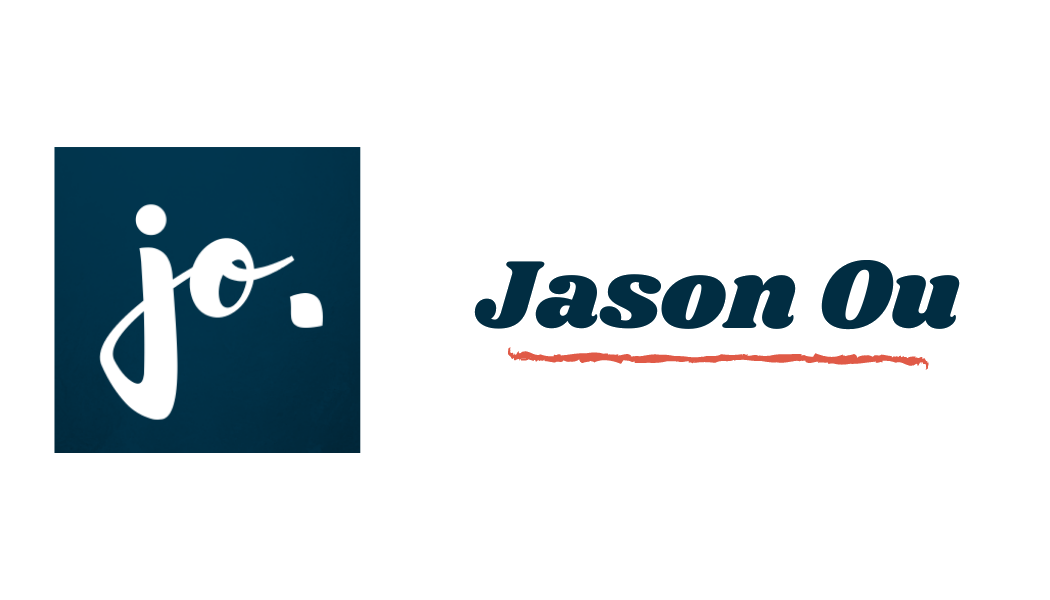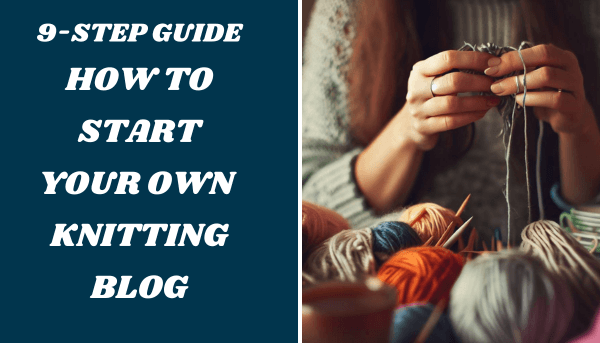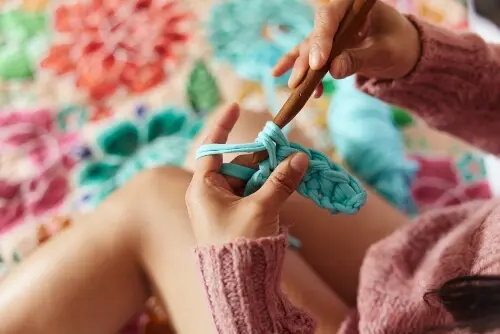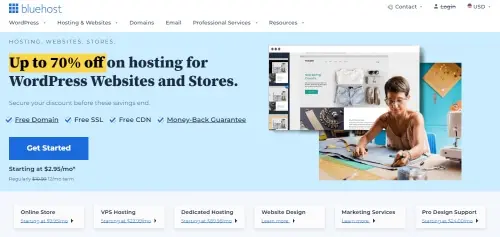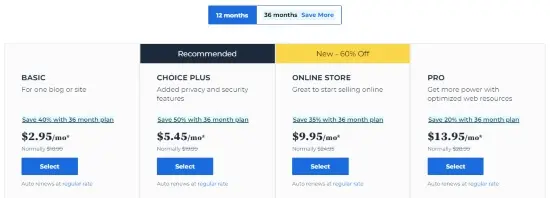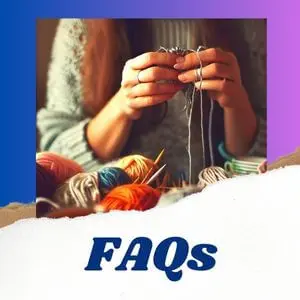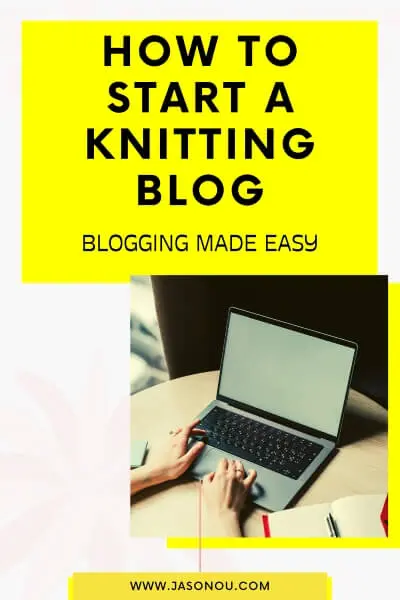How to Start a Knitting Blog in 2024
So, you’re a passionate knitter with an itch to share your love for all things yarn and needles. You’ve seen those inspiring knitting blogs online and thought, “Hey, I could do that too!”
Well, you can. Just Googling how to start a knitting blog tells me you are ready to create a craft and knitting blog today.
So. Allow me to guide you through every step of creating and launching your own knitting and crochet blog by sharing easy-to-follow instructions and proven strategies for blogging success. Step. By. Step.
Key Takeouts
- Choose a specific knitting niche, research competitors, and create valuable content to build a loyal following.
- Select a reliable hosting provider and install WordPress to customize your blog’s appearance with free or premium knitting themes.
- Share the most awesome content with your readers. Consistently.
- SEO your knitting blog and start generating eyeball traffic to it.
- Monetize your blog through affiliate marketing or selling patterns, courses, or merchandise.
- Starting a knitting blog offers benefits such as connecting with like-minded individuals globally and sharing skills while building an online community.
How to Start a Knitting Blog in 9 Steps
This page have some affiliate links. In other words, if you buy from my links, I may get a commission. And some of the images were sources from Unsplash+.
- Register a domain name.
- Sign up with a reliable web host provider. I recommend Bluehost.
- Install WordPress.
- Select a design for your website and blog.
- Install plugins to enhance your blog.
- Create the main pages for your blog.
- Start your keyword research.
- Publish your first blog post.
- Generate traffic to your knitting blog.
Ready to start a knitting blog? Click here to skip the introduction and start creating your banging blog right now.
What Is A Knitting Blog?
A knitting blog is an online platform dedicated to the world of knitting, providing readers with valuable information, practical tips, and inspiration about this popular craft.
Knitting bloggers typically share their personal experiences along with helpful resources such as step-by-step photo guides or video demonstrations.
To illustrate, some blogs offer simple designs for beginners in the craft, while others provide complex patterns for elaborate sweaters or blankets.
In addition to promoting camaraderie within a tight-knit circle (pun intended), many successful bloggers have cultivated thriving businesses out of their passion for knitting.
They often achieve this through selling patterns they create themselves or offering memberships that grant access to exclusive content provided by AllFreeKnitting.com or 47 Sheep.
Benefits Of Starting A Knitting Blog
Starting a knitting blog has several benefits such as connecting with other knitters, sharing your passion and knowledge, and even generating income through affiliate marketing or selling patterns.
Connect With Other Knitters
Starting a knitting blog allows you to connect with fellow knitters from all around the world, creating a sense of belonging within an online community.
By sharing your knowledge, passion, and experiences about knitting through engaging content and tutorials, you can foster relationships with other like-minded individuals who share similar interests.
Furthermore, participating in online forums or commenting on other knitting blogs helps strengthen these connections while providing opportunities for collaboration and networking.
For instance, exchanging tips and tricks or discussing yarn preferences can lead to great conversations and friendships within the knitting community.
Share Your Passion And Knowledge
Starting a knitting blog allows you to showcase your love for the craft and share your expertise with others who have similar interests.
It provides an opportunity to teach beginners new techniques, offer advanced guidance for experienced knitters, and inspire creative minds by sharing your own projects or highlighting patterns from other sources.
As you create content for your blog, consider incorporating personal stories about how knitting has impacted your life or discussing the history behind particular stitches.
This not only educates readers but also helps build a sense of community among fellow knitting enthusiasts.
Generate Income
Starting a knitting blog can provide an excellent opportunity to earn some extra income. There are various ways that you can make money through your knitting blog, including affiliate marketing and selling tutorials or patterns online.
One way to monetize your blog is by using display ads which allow companies to place advertisements on your website in exchange for payment.
Another option is to become an influencer within the knitting community. This involves partnering with brands for sponsored posts and receiving free products in return for promoting them on social media or the blog itself.
Ultimately, there are plenty of ways that you can generate income from blogging about what you love.
Again. It just takes time, effort, and patience.
How Much Does It Cost to Build a Blog Website in 2024.
Planning Your Knitting Blog
To start a successful knitting blog, it’s important to plan ahead.
This includes selecting a niche and researching competitors to differentiate your content.
Select A Profitable Niche
One of the most important steps in starting a knitting blog is selecting a specific niche to focus on. This could be anything from beginner patterns and tutorials to budget-friendly knitting options or minimalist designs.
By choosing a niche, you can establish yourself as an expert in that area and attract readers who are specifically interested in that type of content.
Once you have a niche in mind, see if it is possible to earn money blogging. Can you monetize it with affiliate marketing, selling courses, and so on?
It’s also worth researching your competitors to see what they offer and identify gaps in the market where you can stand out.
(And then see how they are monetizing their blog.)
For example, if there are many blogs focused on advanced knitting techniques, you might find success by targeting beginners with easy-to-follow tutorials or focusing on specific types of projects like baby knits or accessories.
Research Competitors And Examples
To make your knitting blog stand out, you must research competitors and examples.
This step is essential for validating a knitting blog idea and identifying successful strategies to emulate or avoid.
An example of a tool that can help analyze competitors’ keywords is SERANKING. You can use this tool to see which keywords your competition currently ranks on search engine results pages (SERPs).
That said. Let’s go through the steps to starting a knitting blog.
Want an effective keyword tool to spy on your competition? Discover the Best Keyword Rank Tracking Software in 2024.
Time To Start A Knitting Blog
To start a knitting blog, first, select a domain name and a reliable hosting provider.
Next, install WordPress and choose a fitting knitting blog theme.
Customize the blog with your branding and perform keyword research to plan your content strategy.
Then optimize your blog. Promote it. Finally, publish your debut post.
Step 1 – Choose A Domain Name
When starting a knitting blog, the domain name is your website’s address. It should be unique, easy to remember, and relevant to your niche.
For example, if you plan to create a knitting blog focused on teaching beginners how to knit, consider including “beginnerknitting” or “learntoknit” in your domain name.
It’s best to choose a top-level domain (TLD) like “.com,” “.net,” or “.org.” TLDs are seen as more legitimate by readers and search engines alike.
If you’re having trouble coming up with ideas for an interesting domain name, check out some of your competitors’ blogs or brainstorm with friends and family for suggestions.
You can register a domain name with Namesilo and claim a $1 discount using this special code – blogaway
Step 2 – Select A Hosting Provider
One of the most crucial steps to starting your knitting blog is selecting a hosting provider.
This process involves choosing a reliable service and support with options for scalability and security.
Your hosting provider should offer a user-friendly interface, quick load times, backup and restore features, as well as integrate easily with WordPress or other blogging platforms.
It’s essential to choose a hosting provider that has an excellent track record of customer service and security measures.
Pricing, payment options, and uptime guarantee are also factors to consider when making your decision.
Don’t be hesitant in researching and comparing different providers before settling on one that works for you.
The one I recommend is Bluehost. It’s affordable. It’s reliable. It’s easy to use.
Best of all, you can start a knitting blog with Bluehost in less than 30 minutes (or sooner).
For only $2.95 a month, you can’t go wrong.
Here’s Bluehost’s pricing table. The Choice Plus plan includes a free SSL, a free domain name, one-click WordPress installation, fast loading time and a high up-time.
I’m not going to go deep on the set-up. So here’s a post on how to start a knitting blog with Bluehost step-by-step 👇below👇.
A Step-By-Step Beginners Guide to Starting a Blog on Bluehost.
Step 3 – Install WordPress
Fun fact: According to W3Techs – Out of all the websites whose content management system is known, WordPress is used by 63.2%. This means that it is used by 43.1% of all websites. Now, that is a large share. After selecting a domain name and choosing hosting, the next step to start your knitting blog is installing WordPress. WordPress is one of the most popular blogging platforms that offers a user-friendly interface for beginners. You can install WordPress with just one click from a hosting provider like Bluehost. Moving on. Once you’ve installed WordPress, you can customize your blog’s appearance and functionalities by searching for knitting themes and installing them on your website. An example of a great theme for knitting blogs is “Knitting With Love” by 7Theme.Step 4 – Find A Knitting Blog Theme
Choosing the right theme for your knitting blog is crucial in creating an appealing and user-friendly website. WordPress offers various free themes specifically designed for knitting blogs that you can browse under the Appearance menu. Some popular options include Blossom Feminine, Astra, and Ashe. Free themes are a good start for beginners who want to start their blog with minimal investment in customization. But if you want more flexibility in your design, a paid theme is recommended. Here’s why:- Constantly Updated: Developers regularly update premium WordPress themes. Free themes don’t.
- More Features: By purchasing a premium theme, you will have access to all the features it offers. This is not the case with most free themes.
- Optimized: Premium themes are optimized for mobile devices and SEO. All you need to do after purchasing the theme is to upload and activate it on your blog.
- Customer Support: Premium themes come with tech support, making them a great choice for novice knitting bloggers.
- Enhanced Security: Paid themes are equipped with built-in security features that combat malicious code, which helps keep your website secure.
Personalize Your Blog
Personalizing your knitting blog is an essential step to making it stand out from the crowd. Your blog’s design, colors, and fonts should reflect your personality and style as a knitter. Make sure to have a consistent look throughout the pages and posts. For example, if you like minimalist designs or bold colors for your knitting projects, choose complementary backgrounds or frames that match them. Use high-quality images of your work to showcase them on the homepage or portfolio page. When done right, personalization can help create brand recognition among readers who will start associating blogs with particular visual elements such as logo font choice. But. Try not to be a perfectionist and make things all look perfect. The last thing you want is to spend way too much time on beautifying it. You want to be blogging the best content and get it out there soon so you can attract readers to your knitting blog. To put it bluntly. Without traffic and content, no one will read your perfect blog. Ever. You can always touch up your blog when traffic starts coming in.Step 5 – Install Plugins For Your Knitting Blog
WordPress plugins are like add-ons that can be installed on a WordPress website to improve its functionality. You can use it to add new features, improve website performance, optimize search engines, and more. Here are 8 WordPress plugins that are useful for a beginner blogger running a knitting blog:- All in One SEO: This helps to SEO your blog for search engines.
- Jetpack: This helps with website performance, security, and marketing campaigns.
- TinyPng: This plugin helps optimize your images for faster loading times.
- Contact Form 7: This allows you to create custom contact forms for your blog.
- FMTC Affiliate Disclosure: This plugin helps with FTC compliance by adding an affiliate disclosure to your blog posts.
- WP Rocket: This plugin helps with website speed optimization.
- Tasty Pins: This plugin helps with Pinterest optimization by allowing you to add Pinterest-specific descriptions and images to your blog posts.
- UpDraft Plus: This plugin allows you to back up your website. A must-have.
The Best Plugins for a Powerful WordPress Blog.
Step 6 – Post Essential Pages
The next step is to create the main pages for your blog. It is crucial to take the necessary time to carefully create the content on your main pages. This helps to establish trust with your audience. The main pages on your knitting blog should consist of the Home, About, Contact, and Privacy Policy pages. Let’s examine each of them more closely. Home Page – Welcome to the homepage of your blog! Here, you will provide a brief overview of the content available on your site. About Page: Take the opportunity to let your personality shine by sharing information about yourself, such as why you decided to start a knitting blog and more. And while you’re at it, add a photo of you to make it even more personal. It is a great way to connect with your audience and show them what kind of value they can expect from your blog. Contact Page: This is important because it allows your readers to reach out if they require assistance or wish to collaborate. Use a simple plugin like Contact Form 7 to create a nice-looking contact form. Privacy Policy Page: If you obtain any personal information, such as names or emails, from those who visit your blog, you must have a privacy policy agreement. By law. The purpose is to inform website visitors about the way you collect and manage their data. You can check out my privacy policy page.If you want to cover all the legal bases for your knitting, then check out this legal bundle template that I use for my blog here. It’s worth it.Along with the Privacy Policy, you can add other legal pages to your knitting blog. For instance, a Copyright page can clarify that the content on the blog is entirely yours, and you do not permit the use of any content without your permission. So, take the time to create these main pages for your awesome knitting blog.
Step 7 – Conduct Keyword Research
Conducting keyword research is vital in creating a successful knitting blog. The right keywords can increase your chances of ranking higher in search results and drive more traffic to your site. To conduct effective keyword research, you can use keyword tracking software such as SERanking or Google Keyword Planner to identify low-competition keywords that are related to your niche. It’s also essential to consider user intent when selecting keywords. What questions might someone have when searching for topics related to your blog? You can find these questions by looking at the “People Also Ask” (PAA) section on Google search results pages. By addressing those questions and using them as subheadings in your post, you stand a better chance of getting featured snippets on SERP (Search Engine Results Pages). Or you can create a knitting blog post for each PAA.Step 8 – Publish Your First Blog Post
Once you have your knitting blog set up and personalized, it’s time to publish your first post. Before getting started, it’s important to consider what type of content will resonate with your audience. To ensure that your first blog post is successful, make sure it is well-written and provides value to the reader. Use clear and concise language and break up long paragraphs into smaller chunks for improved readability. Remember that building an audience takes time. So, don’t get discouraged if you don’t see immediate results from publishing your first post. It’s a long-term thing.Step 9 – Marketing Your Knitting Blog
You want traffic. You want engagement.
Without it, your blog will not be read.
To increase traffic and audience engagement on your knitting blog, consider these strategies:
- Optimize your content for search engines (SEO).
- Use social media to your advantage.
- Employ effective content marketing tactics.
- Use email communication wisely.
- Explore paid advertising options.
SEO Your Knitting Blog
Search Engine Optimization, or SEO, is a crucial aspect of any successful knitting blog.
It involves optimizing your website’s content and structure to rank higher in search engine results.
This will help potential readers find your blog more easily when searching for knitting-related topics online.
To improve your knit blog’s SEO, you can start by conducting keyword research to identify the most popular keywords and phrases related to knitting that people are searching for.
You can then incorporate these keywords into the following for SEO blogging:
- The first 100 words of your introduction and conclusion.
- Your content.
- Meta title and meta descriptions.
- Header tags (H1, H2).
- Your SLUG URL. For example, if your keyword is how to start a knitting blog. Then turn yourdomainname.com/keyword to yourdomainname.com/how-to-start-a-knitting-blog
- Your image file name. Instead of a jibberish file name, label it as start-a-knitting-blog.jpg
- Add a description with your keyword to the Image ALT tag.
Social Media Marketing
It is a crucial aspect of building a connection with your readers and increasing blog traffic.
Platforms like Instagram, Facebook, Tik Tok, and Twitter, provide opportunities to showcase your knitting projects and connect with fellow knitters using hashtags and groups.
One example of successful social media marketing for knitting blogs is the Knitting With Chopsticks Instagram account.
The blogger posts pictures of her latest knitting projects using aesthetically pleasing themes that resonate with her audience.
Just be sure, you hang out where your readers do.
Pinterest Marketing
Pinterest is a great platform for promoting a blog because it allows bloggers to showcase their content to a large audience and drive traffic to their website.
Pinterest is a visual search engine that allows users to create boards for saving things like blogs, inspirational quotes, knitting inspiration, home decor ideas, and future purchases.
Unlike social media, it is focused on visual content.
By creating pins that showcase your blog content, you can advertise your blog to a wider audience and entice people to click through to read more.
(Sidenote: When pinning to drive traffic to your blog, one simple tip that can make a big difference is to add the title of your blog post to your pin. This can help people understand what your pin is about and encourage them to click through to your blog. Ok?)
With Pinterest, you can advertise your most recent blog post using your logo, a larger headline, and a link that directs back to your website.
According to Pinterest, helpful pins receive 30% more engagement, making it a great way to drive traffic to your blog.
By selectively pinning your blog posts on subjects that already have an audience on Pinterest, you can get better results and increase your blog readership.
Overall, Pinterest is a powerful tool for knitting bloggers to drive traffic to their blogs.
By the way. If you want to know how to attract targeted traffic to your knitting blog with Pinterest, check out Pinteresting Strategies.
Content Marketing
This is a crucial part of growing your knitting blog and increasing traffic.
It involves creating valuable, relevant, and consistent content that will attract and retain readers.
This can take the form of blog posts, tutorials, reviews, or even videos (think Youtube and Reels).
By providing useful information to your audience, you can build a loyal following who will share your content with their own networks.
For example, if you’re writing a post about “knitting patterns for beginners,” you could create an infographic that illustrates the steps involved in knitting a simple scarf.
Or you could write a detailed tutorial on how to knit different stitches.
The more helpful and informative your content is, the more likely it is to be shared by other knitters on social media or through word-of-mouth recommendations.
Collaborate With Other Bloggers And Influencers
Collaborating with other bloggers and influencers is an excellent strategy for growing your knitting blog and reaching a wider audience.
Working together can lead to guest blogging opportunities, social media shoutouts, and even sponsored content.
Partnering with like-minded bloggers or influencers in the crafting industry can also help improve your site’s SEO by creating backlinks to your page.
(Backlinks from relevant websites are important for your SEO efforts.)
It’s important to give credit where it’s due when collaborating, which builds trust between you and your peers while providing value to readers.
Not only that, but collaborations could open doors for partnerships or sponsorships with yarn companies or knitting-related brands.
Email Marketing
Email marketing is a crucial part of promoting your knitting blog and building a loyal fanbase.
It involves collecting email addresses from interested readers, typically through opt-in forms on your website or social media channels.
Once you have a list of subscribers, you can send them newsletters with links to recent blog posts, exclusive content, and other updates.
Successful email marketing requires effective communication that provides value to your subscribers and encourages engagement.
This includes segmenting your list based on interests or demographics so that you can tailor messages accordingly.
Using professional email marketing services like Moosend can also help automate the process and provide analytics to track success.
Paid Advertising
This is optional.
Paid advertising is an effective way to promote your knitting blog by reaching a larger audience quickly. Although it can be costly, paid advertising can generate significant returns on investment when done right.
You can use social media platforms like Facebook and Instagram Ads to showcase visually appealing knitting projects and attract potential readers or customers.
Or even Google Ads.
It’s worth noting that paid advertising should only be considered once your knitting blog has been established and generates some income.
You also need to track and adjust your ad campaigns regularly, as they require ongoing optimizationfor maximum effectiveness.
Monetizing Your Knitting Blog
Affiliate Marketing
Let’s talk about affiliate marketing. It is a popular way to monetize your knitting blog. It involves promoting someone else’s product or service and earning a commission when someone purchases through your unique affiliate link. For example, you could become an affiliate for a yarn store and include links to their products in your blog posts. To be successful with affiliate marketing, it’s important to choose products that are relevant to your audience and genuinely helpful or interesting. You also need to disclose that you’re using affiliate links in accordance with FTC guidelines. (By the way, I do have some affiliate links on this blog.) To sign up for affiliate programs, you can apply directly with the merchant or through affiliate programs like Amazon Associates, Clickbank, ShareASaleSelling Patterns And Tutorials
As a knitting blogger, you can earn money by selling patterns and tutorials to your readers. By sharing your knowledge in the form of paid content, you can monetize your blog while providing value to your audience. To create compelling knitting tutorials, start by identifying what topics are most useful and interesting to your audience. Consider offering beginner-level tutorials for those just starting out, as well as advanced techniques for experienced knitters. When it comes to monetizing pattern sales, there are many different platforms available including Ravelry and Etsy. These sites allow designers to market their patterns directly to consumers while also providing tools like payment processing and customer support.Display Advertising
It’s a type of digital advertising that uses images, videos, and text to promote a product or service. Display ads are placed on third-party websites in the form of banners, images, and text ads. As a blogger, you can earn money from display advertising by placing ads on your blog and earning a commission for each click or impression. Here are some ways you can earn money from display advertising:- Join an ad network like Google AdSense or Media.net to place ads on your blog. Ad networks pay bloggers a commission for each click or impression on the ads.
- Sell ad space directly to advertisers. This can be done by reaching out to potential advertisers or by using a platform like BuySellAds.
- Use affiliate marketing to earn money from display advertising. This involves promoting products or services on your blog and earning a commission for each sale made through your affiliate link.
- Optimize the placement of your ads to increase your earnings. Placing ads above the fold, near the content, and in high-traffic areas can help increase clicks and impressions.
Offering Knitting Courses And Workshops
Once a knitting blog has established its audience and content, it can start offering knitting courses and workshops. This is a great way to earn income while sharing expertise with others. One example is “Knit Your First Sweater,” which could be a six-week online class covering everything from selecting yarn and needles to finishing touches. Another option might be a one-day in-person workshop on how to make intricate lace shawls, using basic skills like increasing/decreasing stitches alongside specialty techniques like lifelines. You could even try webinars with live training or with pre-recording.Selling Knitting Supplies And Merchandise
As a knitting blogger, you can take advantage of your platform to sell knitting supplies and merchandise. This is an excellent way to generate income while sharing your passion with others. Popular items that you could sell on your blog include knitting needles, yarns, patterns, accessories (for example stitch markers or project bags), and other tools needed for the craft. By offering these products through your website, you provide a convenient one-stop shop for fellow knitters while earning some extra cash at the same time. As mentioned earlier, monetizing your blog takes time and dedication. But if done the right way, it could supplement part-time income or be a full-fledged business venture over time. Those are just some of the ways you can make money as a knitting blogger. For more ideas, check out the article below.15 Proven Ways Bloggers Make Money Online
Top Knitting Blog Examples
For inspiration and competition research, check out some of the best knitting blogs out there for beginners, experts, trendsetters, and more.
You might find some content gaps that need to be filled and drive more traffic to your knitting blog.
Knitting Blogs For Beginners
AllFreeKnitting.com is a great example of a blog dedicated solely to beginner knitters, with categories like Learn to Knit and Accessories providing comprehensive guides for those just starting out.
Mama in a Stitch offers simple yet stylish designs perfect for beginners looking to create minimalist garments and accessories.
Knitting With Chopsticks features video tutorials demonstrating basic knitting techniques such as casting on and binding off, making it an excellent resource for visual learners.
Knitting Blogs For Patterns And Techniques
If you’re looking for knitting blogs that offer patterns and techniques, there are plenty to choose from.
Many bloggers specialize in a particular type of knitting, such as socks or shawls, while others cover everything from beginner projects to advanced techniques.
Another great resource is Mama in a Stitch’s blog, which features beautiful knitted accessories like scarves and cowls.
Knitting With Chopsticks provides tutorials for both knitting and crocheting with detailed step-by-step instructions ideal for beginners.
Very Pink also has an excellent library of video tutorials covering various skills needed by knitters at every level.
Knitting Blogs For Crocheting
If you’re looking to specialize your knitting blog in crochet projects, there are plenty of options available. Crocheting is a popular craft that shares similarities with knitting but has distinct techniques and patterns.
Some excellent blogs focus entirely on crocheting, such as the Moogly Blog or Crochet Concupiscence.
These kinds of blogs provide useful resources for learning basic stitches, creating intricate designs and patterns for home decor, clothing items, or accessories using crochet techniques, and finding inspiration from other crochet enthusiasts.
Knitting Blogs For Knitting Trends
If you’re someone who likes keeping up with the latest knitting trends, then you should check out blogs that focus on this topic.
Knitting trend bloggers typically do a great job of highlighting the newest and most popular patterns, techniques, and products within the knitting community.
Some of the top knitting trend blogs include Tin Can Knits and Purl Soho. These websites feature gorgeous knitwear designs and helpful tips to keep your knitting projects on-trend.
Knitting Blogs For Hipsters
Knitting blogs are a great resource for people interested in the knitting world. For hipsters, there are plenty of unique and fashionable options to choose from.
These blogs also cover current trends in the knitting community with fashion inspiration and reviews of new products.
With social media being an essential part of any blog’s marketing strategy, these sites have active Instagram accounts with followers sharing their completed projects using the blogger’s tutorials or patterns.
Tips For Becoming A Successful Knitting Blogger
Track Your Knitting Blog
It is a must for all knitting bloggers. You need to constantly measure your blog’s performance and see what’s working and what’s not. This allows you to consolidate your strategies whilst enabling you to improve the ones that are not. You can use free tools like Google Analytics and Google Search Console to monitor user behavior on your website and see where your traffic is coming from.Post Consistently
Consistency is key when it comes to building a successful knitting blog. Regularly publishing high-quality content will not only keep your audience engaged but also help attract new readers. Aim to post at least once per week, or blog to a plan. Like, creating an editorial calendar. This can help you plan and organize your content ahead of time, ensuring that you always have fresh ideas and topics to write about. It’s important to note that consistency doesn’t just apply to the frequency of posting. It also includes maintaining a consistent tone and voice in your writing style. This helps establish trust with your audience and creates a sense of familiarity for returning readers. Mix up the type of content you publish as well, including tutorials, tips & tricks, product reviews, or even personal stories related to knitting projects you’re working on. Most of all, put your audience first and provide free useful content to build trust.Engage With Your Audience
This is key to building a loyal following and growing your knitting blog. Responding to comments, emails, and social media messages shows that you care about what your readers have to say and value their input. Another way to engage with your audience is by creating content based on their interests and feedback. For example, if you notice a lot of interest in a specific type of pattern or technique, consider creating more content around that topic.Attend Knitting Events And Conferences
Attending knitting events and conferences can be a game-changer for your knitting blog. It’s an excellent way to gain knowledge, connect with other knitters, and build relationships with industry brands. Attending these events also provides opportunities to network with other bloggers in the community and learn from them about best practices for successful blogging. Some popular knitting events and conferences include Vogue Knitting Live, Stitches West, and Rhinebeck Sheep and Wool Festival. While attending such events can be expensive, some offer scholarships or volunteer opportunities for reduced costs.Keep Learning And Improving Your Skills
As a knitting blogger, it’s important to keep learning and improving your skills. This means staying up-to-date with the latest trends in the knitting community, trying new techniques, and experimenting with different patterns and designs. One way to continue learning is by collaborating with other bloggers and influencers in the field. Reach out to fellow knitters on social media or join a knitting group to make connections that can lead to collaborations. By continually expanding your knowledge of the craft, you’ll be able to offer valuable insights and tips for your readers while keeping them engaged with fresh content on your blog.Actionable Checklist for Blogging Beginners.
How to Start a Knitting Blog For Beginners Checklist
A simple blogging for beginner checklist:
- Research and pick a profitable niche.
- Know who your readers will be.
- Register a domain name.
- Start a Bluehost blog online.
- Design your website with a WordPress theme.
- Install essential WordPress plugins.
- Get a free account with Google Analytics and Google Search Console.
- Create the main pages – About, Contact, Privacy Policy.
- Brainstorm blog ideas.
- Conduct keyword research and find low hanging-fruit keywords.
- Start a blog outline and write it.
- SEO your blog.
- Proofread your draft.
- Publish your blog.
- Submit your new blog to Google Search Console.
- Start promoting it.
- Monetize the blog.
- Start a new blog.
- Grow an email list.
- Analyze the performance of your blog.
Think long-term.
An Ultimate Blog Launch Checklist For Beginners
Start a Knitting Blog : FAQs
Learn more about the top-selling knitted items and how to make a living through your knitting blog by checking out our FAQs section.
How do I choose a niche for my knitting blog?
To choose a niche for your knitting blog, consider your personal interests and expertise within the craft. This could include focusing on specific techniques, yarn types, or even knitting patterns geared towards certain age groups or skill levels.
What are some essential elements to include in my knitting blog?
Key elements to include in your knitting blog may comprise tutorials, reviews of products & tools, inspiration & trends related to the hobby as well as personal anecdotes that bring value and relatability to readers. Captivating images also play a crucial role in visually engaging audiences and enhancing their experience on platforms such as Pinterest, which has renowned potential for driving traffic back to blogs.
How can I grow my audience for my knitting blog?
Growing an audience requires consistency in posting valuable content across several channels- including social media which is typically how most beginners discover new sites today- it helps connect with people who share common interests along the way. It’s important(when possible)to reply promptly and engage consistently with followers so they stay invested in what you’re creating over time while attracting new readers/followers simultaneously through shares/mentions etc!
Can I monetize my knitting Blog?
Monetizing takes time. To build up a sizeable (and loyal) following first; after accomplishing this you can then explore different options available from affiliate marketing partnerships with product/s that align with your theme/niche all the way through accepting sponsored posts from brands interested in advertising via various means connecting you w/readership – The amount of earnings garnered depends upon several factors including website traffic stats/page views per month plus engagement rates across other popular social media platforms!
What knitted items sell best?
Knitted items have always been popular among the masses, and certain items tend to sell more than others. Beanies/hats, scarves, and blankets or throws are some of the best-selling knitted items.
These products appeal to a broad audience, making them ideal for selling on your knitting blog. Baby clothes such as booties and sweaters also do well as they make great gifts for new mothers; thus targeting this specific niche can bring in good sales too.
Also, unique designs like minimalist patterns with modern twists or unconventional color combinations tend to be popular among younger customers who enjoy hipster knitting trends.
Can I make a living knitting?
Yes, you can make a living knitting! Many successful knitting bloggers use their blog as their primary source of income.
There are different ways to monetize a knitting blog, including advertising revenue from displaying ads on your site, affiliate marketing by promoting and selling products from other companies and earning commissions from the sales made through your unique referral link, and selling products or services related to knitting such as patterns or tutorials.
You don’t need to be an expert in every aspect of the craft to make a good income; there are plenty of opportunities for knitters with various skill levels.
How to Start a Knitting Blog – Summary
Starting a knitting blog can be a fun and rewarding adventure for any knitting enthusiast.
By following the nine simple steps we outlined in this post, you can quickly set up your own knitting blog and start sharing your passion with others.
Remember to choose a niche that interests you, research your competitors, and focus on creating high-quality content to drive traffic to your site. And promote it.
That is how to start a knitting blog in 2024!
Disclosure: This post may contain affiliate links, which means I’ll receive a commission if you purchase through my links, at no extra cost to you. Please read full disclosure for more information.
You Might Want to Check This Out Too
Resources To Grow Your Business With
Hi, I’m Jason Ou (surname aka, Oh). I am a Solopreneur and Blogger. My mission is to help fellow entrepreneurs (like you) to profit from their passion online. Let’s connect on Facebook now.
